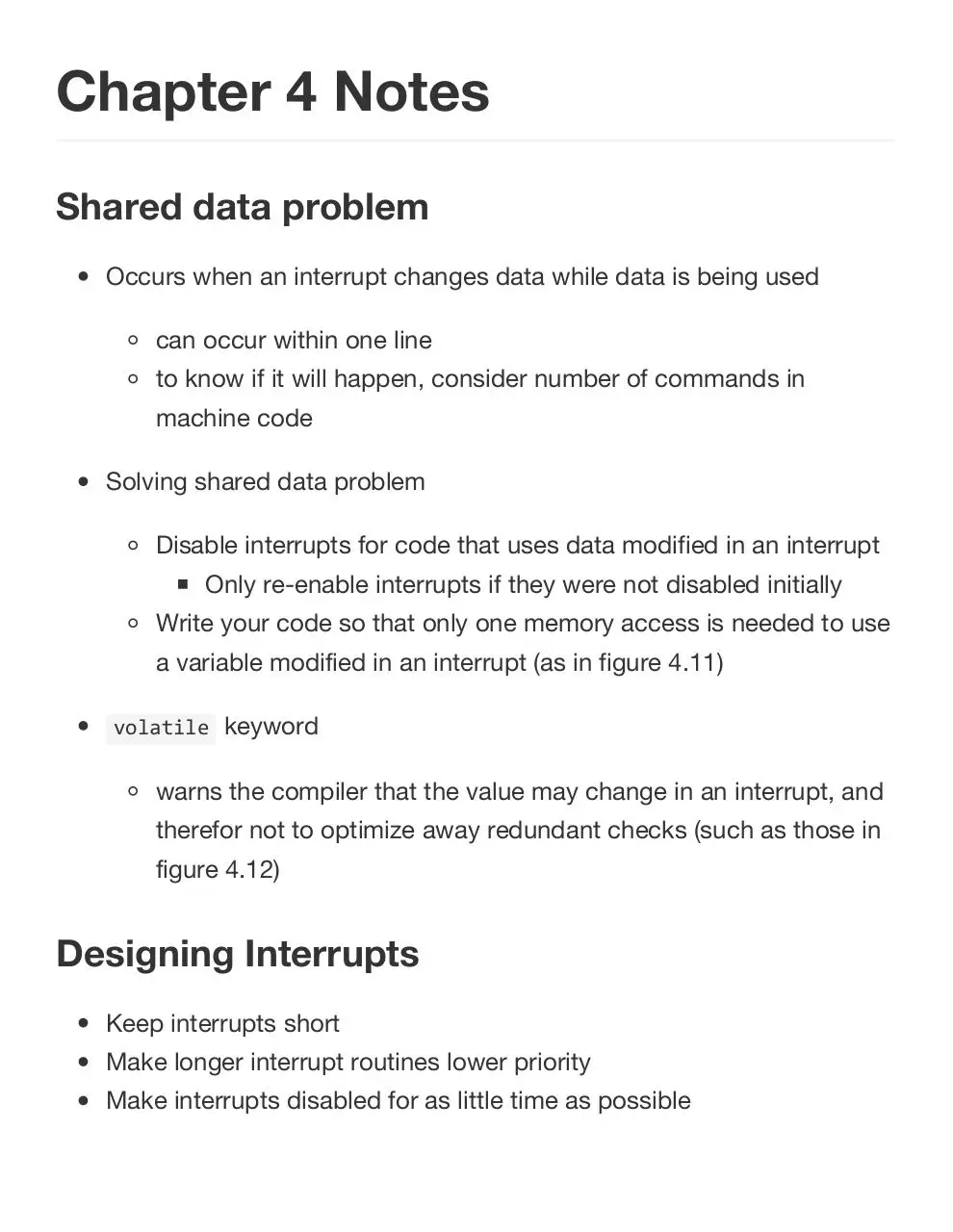hw 1 notes (1) (PDF)
File information
This PDF 1.4 document has been generated by / Qt 5.5.1, and has been sent on pdf-archive.com on 26/03/2017 at 23:12, from IP address 24.16.x.x.
The current document download page has been viewed 561 times.
File size: 47.1 KB (6 pages).
Privacy: public file





File preview
Chapter
4
Notes
Shared
data
problem
Occurs when an interrupt changes data while data is being used
can occur within one line
to know if it will happen, consider number of commands in
machine code
Solving shared data problem
Disable interrupts for code that uses data modified in an interrupt
Only re-enable interrupts if they were not disabled initially
Write your code so that only one memory access is needed to use
a variable modified in an interrupt (as in figure 4.11)
volatile keyword
warns the compiler that the value may change in an interrupt, and
therefor not to optimize away redundant checks (such as those in
figure 4.12)
Designing
Interrupts
Keep interrupts short
Make longer interrupt routines lower priority
Make interrupts disabled for as little time as possible
Vocabulary
Atomic
An "atomic" section of code cannot be interrupted Between
noInterrupts(); and interrupts();
Critical
Section
A "critical section" is a section of code that can be messed up by
interrupts/must be atomic for the code to run properly
Interrupt
Latency
The amount of time it takes for the system to respond to an interrupt
HW
1
Problems:
4.2
Figure 4.11 has a shared data bug when the registers in the
microprocessor are not as large as the data space needed to store a long
integer. Suppose that long integers are 32 bits long and that your
microprocessor has 16-bit registers. How far off can the result of
lSecondsSinceMidnight be? What if your microprocessor has 8-bit
registers?
Answer:
a)
I'm
not
sure
which
of
the
following
is
correct
(if
any)
FFFF FFFF = 4294967295
- 0000 FFFF = 65535
= 4284801760
Off by 4284801760
-OR FFFF FFFF = 4294967295
- FFFF 0000 = 4284801760
= 65535
Off by 65535
b)
I'm
not
sure
which
of
the
following
is
correct
(if
any)
FF FF FF FF = 4294967295
- 00 00 00 FF = 255
= 44294967040
Off by 44294967040
OR
FF FF FF FF = 4294967295
- FF 00 00 00 = 4278190080
= 16777215
Off by 16777215
4.3
Even if your microprocessor has 32-bit registers, Figure 4.11 has another
potential subtle bug. This bug will show itself if your system has an
interrupt that is higher priority than the timer interrupt that corresponds to
vUpdateTime and if the interrupt routine for that higher-priority interrupt
uses lSecondsSinceMidnight . What is this bug, and how might you fix it?
Answer:
This bug would occur if the higher priority interrupt routine was run while
vUpdateTime was performing the arithmetic within the if statement. That
could result in lSecondsSinceMidnight() returning 86400 instead of 0 at
the beginning of a day.
I would fix this bug by either moving or copying the if statement in the
vUpdateTime(); interrupt into lSecondsSinceMidnight() .
4.4
If we change the problem in figure 4.14 so that the networking interrupt is a
lower-priority interrupt and if we assume that the interprocessor interrupt
takes 350μsec, then what is the worst-case interrupt latency for the
networking interrupt?
Answer:
350μs + 250μs = 600μs ?
10.2
a)
Block A is atomic assuming there are no other interrupts
Block B is atomic because that command is accomplished with a single
line of assembly code. Any interrupts will not be called in that line.
Block C is atomic if the function foo() disables interrupts
b)
c)
10.4
Answer:
This program will not work as intended if the accelerator is pressed, and
the brake is pressed between ISRA() checks that alerted is equal to zero
and setting the message to normal. If this were to happen, the display
would read "emergency" for an instant, and then return to displaying
"normal"
10.7
a)
It is possible for the ISR to change the values of sensor1 while the main
method checks if it's faulty. This is because the ifFaulty1() method is not
atomic, and can therefor be interrupted.
b)
It's possible that a sensor would read not faulty even though it was if the
ISR was called during the isFaulty1() or isFaulty2() methods, between
when they determine the state of the sensor and when they return the
value.
c)
The code would never get the chance to run isFaulty1() or isFaulty2()
if the time between the interrupt being called was shorter than the interrupt
latency.
Download hw-1-notes (1)
hw-1-notes (1).pdf (PDF, 47.1 KB)
Download PDF
Share this file on social networks
Link to this page
Permanent link
Use the permanent link to the download page to share your document on Facebook, Twitter, LinkedIn, or directly with a contact by e-Mail, Messenger, Whatsapp, Line..
Short link
Use the short link to share your document on Twitter or by text message (SMS)
HTML Code
Copy the following HTML code to share your document on a Website or Blog
QR Code to this page

This file has been shared publicly by a user of PDF Archive.
Document ID: 0000574766.